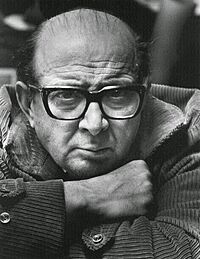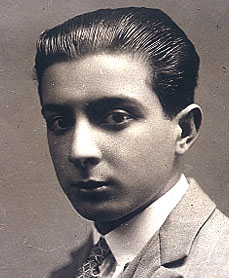Antonio Berni facts for kids
Quick facts for kids
Antonio Berni
|
|
|---|---|
 |
|
| Born |
Delesio Antonio Berni
14 May 1905 Rosario, Argentina
|
| Died | 13 October 1981 (aged 76) Buenos Aires, Argentina
|
| Known for | Painting, Engraving, Illustration, Collage |
|
Notable work
|
Juanito Laguna Ramona Montiel La Manifestación |
| Style | Surrealism |
| Movement | Nuevo Realismo |
Delesio Antonio Berni (born May 14, 1905 – died October 13, 1981) was a famous Argentine artist. He created art that showed real people and scenes. He was part of a style called Nuevo Realismo (which means "New Realism"). This style was a bit like social realism, focusing on everyday life and social issues. His art, especially his Juanito Laguna collages, showed the struggles of people living in poverty and how factories changed cities like Buenos Aires. His amazing artwork has been shown all over the world!
Contents
Antonio Berni's Life
Early Years
Antonio Berni was born in Rosario, Argentina, on May 14, 1905. His mother, Margarita Picco, was Argentine with Italian parents. His father, Napoleon, was a tailor from Italy who had moved to Argentina. Sadly, his father died during World War I.
When he was nine, Berni started learning about stained glass with a craftsman named N. Bruxadera. Later, he studied painting at the Rosario Catalá Center. People quickly noticed his talent and called him a "child prodigy." By 1920, when he was just 15, seventeen of his oil paintings were shown in an art exhibit called Salon Mari. Art critics even praised his impressionist landscapes in major newspapers in 1923.
Studying in Paris
In 1925, a group called the Jockey Club of Rosario gave Berni a scholarship to study art in Europe. He first visited Spain, where Spanish painting was very popular. He traveled to many cities like Madrid and Seville. But he eventually settled in Paris, France, which was a hub for artists. Many other Argentine artists were also there.
In Paris, Berni took classes from famous artists like André Lhote. During this time, he painted several landscapes and still life works.
He returned to Rosario for a short time but went back to Paris in 1927 with another scholarship. While there, he became very interested in surrealism. This art style explores dreams and the subconscious mind. Berni saw surrealism as a fresh way to look at art and the world, especially after World War I. His surrealist paintings from this period include The Eiffel Tower in Pampa and Death Lurks Around Every Corner.
Berni also started learning about politics, including Marxism. He even met a Communist poet named Louis Aragon. Berni and Aragon wrote letters to each other, discussing how art and politics are connected. Berni also helped distribute Asian newspapers in Paris and contributed his illustrations to them.
New Realism Period
In 1931, Berni returned to Argentina. The country was very different from Paris. He saw many people struggling with unemployment and witnessed protests. He was also shocked by a military takeover in Buenos Aires (known as the Infamous Decade). Berni felt that surrealism couldn't truly show the sadness and frustration of the Argentine people. So, he joined the local Communist party and helped organize a group for students and artists.
He met a Mexican artist named David Alfaro Siqueiros, who painted large political murals. In 1933, Berni worked with Siqueiros and other artists on a mural called Plastic Exercise. However, Berni later felt that murals might not be the best way to inspire social change.
Instead, Berni began painting realistic images that showed the everyday struggles of Argentinians. This style became known as Nuevo Realismo (New Realism). His famous paintings from this time include The Unemployed and Manifestation. These works were based on photographs Berni took to show the difficult lives of his subjects. Critics noted that his art perfectly balanced strong social messages with unique artistic style.
Berni believed that art should reflect the world around us. He said that social realism helped show the spiritual, social, political, and economic realities of society.
1940s, 1950s, and Early 1960s
In 1941, Berni traveled to countries like Bolivia and Peru to study pre-Columbian art (art from before Europeans arrived). His painting Indian Market was inspired by the photos he took during this trip.
A few years later, he won a major award at the Salón Nacional. He also helped start a mural workshop with other artists. They decorated the dome of the Galerías Pacifico building.
The 1940s were a time of many changes in Latin America, including political takeovers. Berni responded with more political paintings like Massacre and The Dead Worker.
From 1951 to 1953, Berni lived in Santiago del Estero, a region in Argentina that faced environmental problems. While there, he painted two series of works called "Motivos santiagueños" and "Chaco." These were later shown in major cities like Paris and Moscow.
In the 1950s, he returned to a style called expressionism, which focuses on expressing emotions. Works like Axemen and Food show this. He also started painting scenes of suburban life, including Villa Tweety and House of Taylor.
In 1960, Berni's friend Rafael Squirru, who worked for the Argentine government, sent Berni's engravings to the Venice Biennale, a very important art exhibition. Berni won first prize in his category! Squirru continued to promote Berni's work, organizing big shows for him in the United States.
Juanito Laguna and Ramona Montiel
After the 1950s, Berni's art combined elements of Pop Art (which uses images from popular culture) and Social realism. In 1958, he started collecting discarded materials like old wood, bottles, and metal. He used these to create a series of collages about a character named Juanito Laguna.
Juanito Laguna became a symbol of the poor children living in the slums of Buenos Aires. Berni wanted to show how factories and poverty affected people's lives and the big differences between rich and poor in Argentina.
Berni explained that he found the materials for his art in the poor areas where Juanito lived. These materials were the same ones used to build the shacks in those neighborhoods.
Art experts say that Berni's Juanito works aimed to show the real lives of people in developing countries. They highlighted the problems caused by new forms of control by powerful countries, leading to poverty and a strong desire for progress.
Some famous Juanito works include Portrait of Juanito Laguna and Juanito Goes to the City. Berni also created art about a similar female character named Ramona Montiel. His art featuring Juanito and Ramona won him the Grand Prix for Printmaking at the Venice Biennale in 1962.
In 1965, a large exhibition of Berni's work, including his "Monsters" collages, was shown in Argentina and the United States. His later works, like Ramona in the Cavern, became more complex. Massacre of the Innocent was shown at the Paris Museum of Modern Art in 1971. By the late 1970s, his Juanito and Ramona oil paintings even became three-dimensional art pieces.
Later Years and Death
After a military takeover in Argentina in 1976, Berni moved to New York City. He continued to paint, engrave, and create collages there. New York seemed very rich and focused on buying things, but Berni felt it lacked spirit. He showed these ideas in his art with a touch of humor. His New York paintings, full of bright colors, include Airport, The Hippies, and Streets of New York. He also created designs for theater sets and illustrations for books.
As he got older, Berni's art became more spiritual. In 1980, he finished two paintings, Apocalypse and The Crucifixion, for a chapel in Argentina.
Antonio Berni passed away on October 13, 1981, in Buenos Aires. He had been working on a monument for a famous Argentine character, Martín Fierro. The monument was finished and opened shortly after his death. In an interview before he died, Berni said, "Art is a response to life. To be an artist is to choose a risky way of life, to be truly free, and to make no compromises. Painting is a form of love, of sharing your life through art."
Legacy
Since the late 1960s, many Argentine musicians have written songs about Juanito Laguna. Famous singer Mercedes Sosa recorded songs like Juanito Laguna remonta un barrilete. In 2005, a CD was released to celebrate Berni's 100th birthday. It included songs by various artists and even short recordings of Berni speaking.
After his death, Berni received the Honour Konex Award in 1982, recognizing him as the most important deceased artist from Argentina.
In 2005, several Argentine government groups celebrated Berni's 100th birthday. His daughter, Lily, organized an art show called A painting for Juanito, 40 years later. Through a program called De Todos Para Todos (By All For All), children across Argentina learned about Berni's art and then created their own collages, just like he did.
In July 2008, a sad event occurred: thieves dressed as police officers stole fifteen of Berni's paintings. The paintings were being moved to the Bellas Artes National Museum. Officials said the paintings were "of great national value" and called the robbery "an enormous loss to Argentine culture."
Images for kids
See Also
 In Spanish: Antonio Berni para niños
In Spanish: Antonio Berni para niños
- Louis Aragon
- Culture of Argentina
- Infamous Decade
- Latin American art
- Pop Art
- Social realism
- Lino Enea Spilimbergo
- Rafael Squirru




